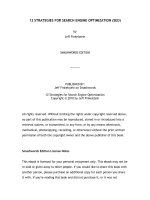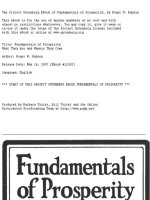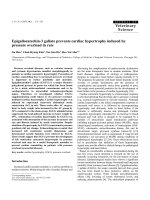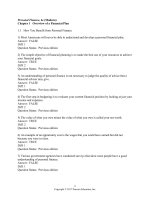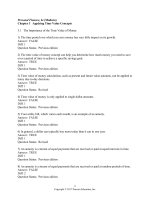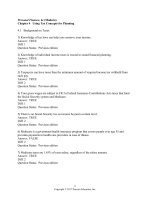Fundamentals hypertrophy program by jeff nippard
Bạn đang xem bản rút gọn của tài liệu. Xem và tải ngay bản đầy đủ của tài liệu tại đây (15.25 MB, 97 trang )
FUNDAMENTALS
HYPERTROPHY
PROGRAM
JEFF NIPPARD
FUNDAMENTALS
HYPERTROPHY
PROGRAM
WRITTEN BY
JEFF NIPPARD
TABLE OF CONTENTS
ABOUT ME
4
ABOUT THIS PROGRAM
6
VKEY TERMS
8
ANATOMY
9
FREQUENTLY ASKED QUESTIONS
20
WARM UP
25
EXERCISE SUBSTITUTIONS
REST DAYS AND TRAINING DAYS
27
30
FULL BODY PROGRAM
32
UPPER/LOWER PROGRAM
48
BODYPART PROGRAM
64
PROGRAM EXPLAINED
80
PROGRAM VARIABLES
84
EXERCISE VIDEO LINKS
87
REFERENCES92
DISCLAIMER96
ABOUT ME
Jeff is a professional drug-free bodybuilder and powerlifter. Through his informative
and entertaining Youtube channel which has gathered a fan-base of over 700,000
subscribers, Jeff aims to share the knowledge he has gathered through university
education and field experience with others who are passionate about the science
behind building muscle, losing fat and getting healthier.
He earned the title of Mr. Junior Canada for natural bodybuilding in 2012 and as a
powerlifter, Jeff held the Canadian national record for the bench press in 2014. As a
powerlifter, Jeff has claimed a 502 lb squat, 336 lb bench press and a 518 lb deadlift
with an all time best Wilks score of 446.
With a Bachelor of Science degree in biochemistry, Jeff has gathered the requisite
scientific knowledge to compliment his practical experience acquired through
JEFF NIPPARD FUNDAMENTALS HYPERTROPHY PROGRAM
4
training and coaching. Jeff has coached women’s bikini and men’s bodybuilding
national and provincial champions, professional natural bodybuilders and nationally
and IPF Worlds qualified raw powerlifters. He has presented seminars on Block
Periodization, concurrent training and nutrition and training for natural bodybuilding
in academic settings including the 2014 Online Fitness Summit and at the University
of Iowa. He has aspirations of completing a PhD in exercise science or a related field.
Jeff currently lives in Kelowna, Canada where he is producing informative YouTube
videos and podcasts while preparing for his next competition season in natural
bodybuilding in 2019.
JEFF NIPPARD FUNDAMENTALS HYPERTROPHY PROGRAM
5
ABOUT THIS PROGRAM
WHAT THIS PROGRAM IS
Before we dive into the anatomy and architecture behind the training program itself,
I want to make it clear what this training manual is intended to accomplish. As I’ll
repeat throughout this document, the primary goal of The Fundamentals Program is
to establish a solid strength base with specifically selected foundational exercises.
There are three separate 8-week programs included: a full body routine (3 days per
week), an upper/lower routine (4 days per week) and a bodypart split routine (5 days
per week). The level of volume and the types of exercises included in each routine
are very similar, meaning that the three routines are equally appropriate regardless
of your experience level. In other words, you will see the same results running either
of the three routines in whatever order you see fit and according to your schedule or
your training preferences. All three are included to provide variety, so that you can
JEFF NIPPARD FUNDAMENTALS HYPERTROPHY PROGRAM
6
pick a routine that suits your needs best and, once you run through it, you have the
option of running another two unique programs for 8 weeks a piece.
WHAT THIS PROGRAM ISN’T
This Fundamentals Training Program manual is not intended to be an all-inclusive
resource for all things training related. I initially wrote this document as a supplement
to my Training Fundamentals YouTube Series, meaning that there will be information
covered in the series that won’t be recapitulated here. At the time of writing, I plan
to release The Fundamentals Book (title subject to change) later in 2018 or early
2019 which will cover anything and everything training related from A to Z. The
main purpose of this program is to provide three tangible, actionable programs
that can be executed without having to understand all of the underpinnings of my
programming science and philosophy. With that said, there is still plenty to chew on
here: just about 90 pages in total, including a full blown anatomy section (something
I didn’t have the chance to cover in my Fundamentals YouTube Series in detail), a
section explaining the specific programming principles at play (volume, intensity,
frequency, etc.), video links for technique demonstration for each exercise and 26
unique scientific references. Still, if you’re an unexperienced new trainee, I would
strongly recommend watching my Fundamentals YouTube Series, since it will help
strengthen your grasp of the concepts being discussed here.
This program isn’t intended to teach or instruct you on basic lifting technique and
assumes you already have a basic understanding of how to perform the exercises
included with proper form. If there are any exercises you aren’t familiar or confident
with, please refer to the video links section for demonstration. It also comes strongly
recommended that you have a personal trainer, coach or experienced friend provide
feedback on your technique for new movements.
JEFF NIPPARD FUNDAMENTALS HYPERTROPHY PROGRAM
7
KEY TERMS
DB: Dumbbell
LSRPE: Last set RPE
PROGRESSIVE OVERLOAD: The gradual increase of stress placed upon the body
during exercise training. In training contexts, this generally involves progressively
increasing some lifting parameter over time (usually weight or reps)
ROM: Range of motion
RPE: Rate of perceived exertion. A measure of how difficult a set was on a 1-10 scale,
with 10 meaning muscular failure was achieved.
TEMPO: The speed at which the lift occurs.
DOMS: Delayed Onset Muscle Soreness
JEFF NIPPARD FUNDAMENTALS HYPERTROPHY PROGRAM
8
ANATOMY
Figure 1: The Main Posterior Muscles
Major muscles of the body.
Ride side: superficial; left side: deep (posterior view)
JEFF NIPPARD FUNDAMENTALS HYPERTROPHY PROGRAM
Figure 2: The Main Anterior Muscles
Major muscles of the body.
Ride side: superficial; left side: deep (anterior view)
9
FUNCTIONAL ANATOMY
It is important to understand the functional anatomy and biomechanics of the
main muscles we’ll be targeting before we can understand how to best train them.
Functional anatomy determines what muscles can do. There are two things to
consider when looking at a muscle’s functional anatomy – its origin and insertion.
Muscles attach to bone by tendons from at least two points. The origin is the fixed
attachment which does not move and the insertion is the attachment which moves
closer to the origin when a muscle contracts. This is the contracting phase, referred
to as the concentric phase (also known as the “positive” phase), which is normally
followed by the eccentric phase (lowering the weight – also known as the “negative”
phase).
QUADRICEPS: The quadriceps (“quads” for short) are
comprised of four muscles, often referred to as “heads”:
the vastus lateralis (“quad sweep”), vastus medialis (“tear
drop”), rectus femoris (the middle portion of your upper
thigh), and vastus intermedius (which runs underneath the
rectus femoris). The quads act to extend the knee, taking
the leg from a bent position to a straight position. Each
muscle of the quad has its own unique insertion which we
won’t worry about too much here. Just remember that the
main action of the quads is to extend (straighten) the knee.
ORIGIN: The vasti muscles originate on the body of femur
(“thigh bone”). The rectus femoris originates on the illium
of the “hip bone”
INSERTION: Tibial tuberosity
EXERCISES: Squat, walking lunge, leg extension
Figure 3: Quadriceps Anatomy
JEFF NIPPARD FUNDAMENTALS HYPERTROPHY PROGRAM
10
HAMSTRINGS: The hamstrings are actually a
complex of four muscles: semimembranosus,
semitendinosus, and biceps femoris (which
consists of a long head and a short head).
The hamstrings collectively act to both flex
the knee (take the leg from a straightened
position to a bent position, as in a leg curl)
and extend the hip (pushing your hips
forward, as in a deadlift).
ORIGIN: The semitendinosus,
semimembranosus, and long head of the
biceps femoris originate on the ischial
tuberosity. The short head of the biceps
femoris originates on the linea aspera.
INSERTION: The semitendinosus and
semimembranosus both insert on the tibia,
while both the long and short heads of the
biceps femoris insert at the fibula.
EXERCISES: Deadlift, romanian deadlift, leg
curl
Figure 4: Hamstrings Anatomy
JEFF NIPPARD FUNDAMENTALS HYPERTROPHY PROGRAM
11
GLUTEALS: The gluteals (or “glutes”) are also a complex of muscles consisting of the
gluteus maximus, gluteus medius, and gluteus minimus. As the name suggests, the
gluteus maximus is the largest of the three, followed by the gluteus medius, and the
smallest gluteus minimus. The gluteus maximus has multiple origins including the
pelvis, sacrum, coccyx, and thoracolumbar fascia and multiple insertions including
the upper femur and IT band. Because of this, it is able to perform a wide variety of
functions, but primarily:
- Hip extension (push your hips forward)
- Hip abduction (move your thigh away from the midline)
- Hip external rotation (rotating your thigh bone outwards)
- Posterior pelvic tilt (tucking your butt “in”)
The smaller glute medius still occupies a hefty portion of the rear hip musculature
and functions primarily as a stabilizer during dynamic movement and as a hip
abductor. It originates on the pelvis and inserts on the femur. It is most effectively
trained with exercises that require a high degree of stability, especially unilateral
movements such as walking lunges, and exercises that train hip abduction, such as
machine hip abductions.
ORIGIN: The gluteus maximus, medius, and minimus
originate on the ilium.
INSERTION: The gluteus maximus and gluteus minimus
insert to the iliotibial tract (IT band) and the gluteal
tuberosity on the femur. The gluteus medius inserts to the
greater trochanter on the femur.
EXERCISES: Hip thrust, squat, walking lunge, deadlift,
machine seated hip abduction
Figure 5: Gluteals Anatomy
JEFF NIPPARD FUNDAMENTALS HYPERTROPHY PROGRAM
12
PECTORALIS: There are two pectoralis muscles (pecs for short) located on your
chest: the pectoralis major and the pectoralis minor. The pectoralis major can be
divided into two heads: the clavicular head or “upper chest” (which originates at
the clavicle) and the sternal head or “lower chest” (which originates at the sternum).
The pecs act to adduct the upper arm (bring the upper arm across the body), and to
internally rotate the shoulder joint. The clavicular fibers also aid in shoulder flexion
(raising your upper arm up), but the sternal fibers do not.
ORIGIN: The pectoralis major originates on the sternum and clavicle. The pectoralis
minor originates on the
3rd-5th ribs.
INSERTION: The
pectoralis major inserts
on the humerus.
The pectoralis minor
inserts to the coracoid
process (front of your
shoulder).
EXERCISES: Bench
press, dumbbell incline
press, cable flies, dips,
Figure 6: Pectoral Anatomy
JEFF NIPPARD FUNDAMENTALS HYPERTROPHY PROGRAM
military press
13
BACK: The back is
comprised of a massive web
of muscles, so for the sake of
simplicity we will only look
at the largest back muscles.
The latissimus dorsi (lats for
short) is a big muscle which
runs from just underneath
your arm pit all the way
down to the bottom of your
back. The lats primarily act to
extend the shoulder (bring
your upper arm downward)
and adduct the shoulder
(moving your elbows
towards your mid back).
The trapezius (traps for
short), is another large
muscle running from the
base of the skull down to the
middle of your inner back.
When people think about
Figure 7: Latissimus Dorsi Anatomy
the traps, they tend to only
think of the upper fibers, but the middle and lower fibers take up a very large surface
area as well. The traps act to elevate the scapulae (shrugging your shoulders), retract
the scapulae (pull the shoulder blades back), and extend the shoulder (pull your
arms backward when your elbows are raised).
JEFF NIPPARD FUNDAMENTALS HYPERTROPHY PROGRAM
14
LATS:
ORIGIN: Illiac crest and thoracolumnar
fascia
INSERTION: Humerus
EXERCISES: Supinated pulldowns,
chest-supported T-bar row, seated face
pull, deadlift (isometric contraction to
prevent shoulder flexion)
TRAPS:
ORIGIN: Occipital bone (upper traps),
corresponding supraspinous ligaments
for the mid and lower traps
INSERTION: nuchal ligament
EXERCISES: Chest-supported T-bar
row, cable seated row, seated face
pull, deadlift (isometric contraction to
prevent scapular depression)
JEFF NIPPARD FUNDAMENTALS HYPERTROPHY PROGRAM
Figure 8: Trapezius Anatomy
15
BICEPS: The biceps brachii
are a two-headed muscle
containing a long head and a
short head. They collectively
act to flex the elbows (bring
the elbow from a straightened
position to a bent position),
and supinate the wrist
(twist the pinky upwards).
The brachialis, which runs
underneath the biceps brachii,
is also a strong elbow flexor.
Figure 9: Biceps Anatomy
ORIGIN: coracoid process, supraglenoid tubercle
INSERTION: Radial tuberosity
EXERCISES: Supinated pulldowns, dumbbell supinated curl, single-arm cable curl
JEFF NIPPARD FUNDAMENTALS HYPERTROPHY PROGRAM
16
TRICEPS: The triceps lie on the back of your upper arm and are made up of three
heads: a long head, a medial head, and a lateral head. The triceps collectively act
to extend the elbow (bring the elbows
from a bent position to a straightened
position).
ORIGIN: Infraglenoid tubercle, radial
groove
INSERTION: Olecranon process on ulna
EXERCISES: Rope triceps extension,
dips, dumbbell skull crusher, bench
press, military press, dumbbell incline
Figure 10: Triceps Anatomy
press
DELTOIDS: The deltoids (or delts for short) are
comprised of 3 different heads, the anterior deltoid
(the “front” delt), the lateral deltoid (also known as the
“middle” delt, and often mistakenly called the “medial
delt”), and the posterior delt (also known as the “rear”
delt). The anterior delt acts to flex the shoulder (raise
the arm up), the lateral delt acts to abduct the upper
arm (raise your upper arm out directly to your sides),
and the posterior delt acts to abduct the shoulder (pull
the shoulder back when the elbows are raised).
Figure 11: Deltoid Anatomy
JEFF NIPPARD FUNDAMENTALS HYPERTROPHY PROGRAM
17
ORIGIN: Clavicle, acromion process, spine of scapula
INSERTION: deltoid tuberosity of humerus
EXERCISES: Military press, dumbbell incline press, barbell bench press, lateral raise,
seated face pull
Figure 11: Abdominal Anatomy
ABS: The abs are a huge web containing many muscles which all have a similar
function. When talking about the abs, we are typically referring to the rectus
abdominis – which is the muscle that makes the “6-pack”. The rectus abdominis acts
to flex the spine, rotate the torso, and resist spinal extension (prevent your lower
back from arching inwards).
ORIGIN: Crest of pubis
INSERTION: Xiphoid process
EXERCISES: Crunches, planks
JEFF NIPPARD FUNDAMENTALS HYPERTROPHY PROGRAM
18
CALVES: The calves are a complex consisting of two muscles
– the gastrocnemius (or gastroc for short) and the soleus.
The gastrocnemius is the big muscle underneath the back
of your knee and the soleus is a smaller, flatter muscle which
runs underneath the gastroc down to your ankle. Both the
gastroc and soleus act to plantarflex the ankle (point your
toes down).
ORIGIN: Lateral and medial condyle of femur
INSERTION: tendo calcaneus
EXERCISE: Standing calf raise
Figure 12: Anatomy of the Calf Muscles
JEFF NIPPARD FUNDAMENTALS HYPERTROPHY PROGRAM
19
F.A.Q.
1: How do I know if I am progressing?
A: Bodybuilding is a marathon, not a sprint. It can be difficult to accurately
determine if you are making visual progress day-to-day or even week-to-week.
Taking physique progress photos every 4-6 weeks and comparing them side by
side is a good way to detect visual differences that you simply wouldn’t notice in the
mirror. But ultimately, because of the relationship between strength gain and muscle
gain, the main metric I want you to use for tracking your progress is strength. If
you’re getting stronger, you’re progressing. It is strongly recommended to log every
workout either in writing (print the program out or use a separate notebook) or in an
app, so you don’t have to rely on memory to keep track of personal strength records.
Taking body measurements a few times a year can also be helpful (arms, thigh, waist,
neck) but simply focusing on steady strength progression will be your best proxy for
determining muscular progress.
JEFF NIPPARD FUNDAMENTALS HYPERTROPHY PROGRAM
20
2: How much muscle can I expect to gain?
A: How you respond to training will be largely determined by genetic factors. As
a rough ballpark estimate for untrained male individuals, 1-2 lbs of muscle gain
per month is reasonable (12-24 lbs of muscle gained in your first year). For early
intermediates with about 1 year of lifting experience, progress will likely slow down
to roughly 0.5-1 lbs of muscle gain per month (6-12 lbs of muscle gained in your
second year). For practical purposes, women can divide muscle gain estimates in
half.
3: What gym equipment should I use?
A: Gym equipment is optional as there are no required pieces of equipment to gain
muscle and increase strength. With that being said, investing in an 10mm prong or
lever belt, knee sleeves, squat shoes, and straps can be beneficial in allowing you to
lift more weight for certain exercises.
YOU CAN FIND ALL OF MY RECOMMENDED EQUIPMENT AT THE FOLLOWING LINKS:
BELTS:
/> />
STRAPS:
/>
KNEE SLEEVES:
/>
SQUAT SHOES:
Adidas Powerlift 3.1 (The squat shoes I currently am using) - Link
JEFF NIPPARD FUNDAMENTALS HYPERTROPHY PROGRAM
21
4: I have a belt. When should I wear it?
A: Optionally use a lifting belt for working sets on exercises like squats, deadlifts and
overhead (military) presses. Strength is a specific skill, so practice every rep in exactly
the same way (meaning, if you’re going to use a belt at all, use it consistently and for
the same movements). I wouldn’t recommend wearing on a belt on light warm-up
sets.
5: I am not getting sore from my workouts. Is the program not working?
A: Muscle soreness is largely attributed to eccentric contractions [22] and long
muscle length contractions [23]. Delayed onset muscle soreness (DOMS) isn’t
required for hypertrophy to occur, but the associated muscle damage might play a
role in hypertrophy [24]. With that said, the main goal of the program is to establish a
strength foundation, not to get you feeling sore. In fact, reduced soreness over time
indicates that your body is adapting and recovering, which is actually a good thing
for continued progress.
6: I am getting very sore from my workouts. Should I skip the gym until I am not
sore?
A: You may experience increased soreness when you first begin the program
because it is presenting a new stress to your body. Foam rolling can help reduce
DOMS [25] and increase ROM [26], so if you are consistently getting sore week
after week, consider adding a short 3-5 minute foam rolling routine at the end of
the workouts. Otherwise, training while sore is not inherently problematic for muscle
growth unless it puts you at an increased risk of injury. If you’re having a difficult
time getting into position for any of the planned exercises, or finding it difficult
to complete a full ROM due to pain, do not train. Otherwise, in the case of mild
soreness, perform a slightly longer warm up for each exercise and use your own
discretion with avoiding injury being a top priority. One extra rest day will not set you
back very far, but a serious injury will.
JEFF NIPPARD FUNDAMENTALS HYPERTROPHY PROGRAM
22
7: Should I eat in a caloric deficit, maintenance, or surplus while running this
program?
A: Eating in a slight caloric surplus will yield the best results and best recovery,
however, if your main goal is fat loss, eating in a caloric deficit will be necessary. As a
beginner, you can continue to make strength and size progress while in a moderate
caloric deficit and achieve body recomposition (lose fat and build muscle at the
same time) if protein intake is sufficient (0.8-1g/lb bodyweight as a ballpark).
8: The warm-up isn’t enough for me. Can I add to it?
A: You can add warm-up exercises to the protocol but your warm-up shouldn’t take
any longer than 10-20 minutes. It is important to stay injury-free, so don’t rush into
your workout.
9. Why is there such little exercise variation from week to week?
A: Changing exercises from week to week is more likely to flatten out the strength
progression curve. While there is some variation from week to week, most exercises
are kept constant to ensure both progression (by adding volume incrementally to
these specific movements) and mastery of exercise form and technique. If after 8
weeks you feel like you need to switch things up, then you can run one of the other 2
programs included in this manual.
10. There are 3 different splits. Which one should I run?
A: Since adherence and sustainability are arguably the most important factors for
long term success, it is important to start with a program that you think you will enjoy
and actually stick to. Have a look through the 3 programs and go with the one that
looks most appealing to you. I am a big fan of the upper/lower split personally, so if
you are totally unsure, that would be a good one to start with.
JEFF NIPPARD FUNDAMENTALS HYPERTROPHY PROGRAM
23
11. What do I do after I finished the program?
A: You have the option of running back through the same program again for
another 8 weeks or moving on to one of the other splits provided. After the 1-2 year
mark of running these programs, you will likely want to graduate on to one of my
Intermediate Programs.
12. What are the blank boxes in the middle of each program for?
A: They are for you to track your weights each week, so you can focus on strength
progression from week 1 to week 8. Of course, this will only work if you print the
program out. The other option would be to keep a notebook and simply pencil
in your lifts each week. Keeping up with this habit of tracking is going to be an
extremely important part of your success on this program.
Please direct all other question to Please avoid directing questions
about this program to my social media as it is not a reliable means of making contact
with me or getting the correct information. Please allow 3-5 business days for an
email reply.
JEFF NIPPARD FUNDAMENTALS HYPERTROPHY PROGRAM
24
WARM UP
Before we look at exactly how you should warm-up, it’s important to consider
what the warm-up portion of your training session serves to accomplish. Warming
up should function to increase your core body temperature, which improves
performance [1] [2]. Your circadian rhythm also helps determine your core body
temperature at any given point in time. When you wake up, your core body
temperature is at its lowest, and it increases throughout the day. There seems to be
a “sweet spot” for core body temperature, so doing 5-10 minutes of low-moderate
intensity cardio is especially prudent if you exercise early in the morning [3].
Secondly, warm-ups serve as a way to increase muscle activation. Doing dynamic
warm-ups (exercises and drills which take you through a range of motion) can
improve performance and force output [4]. Don’t view your warm-up as just “going
through the motions.” The goal is to always be very mindful about the muscles you
JEFF NIPPARD FUNDAMENTALS HYPERTROPHY PROGRAM
25



